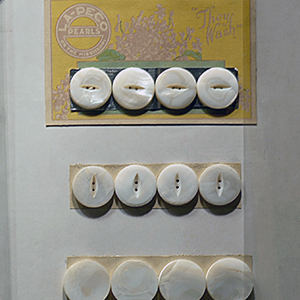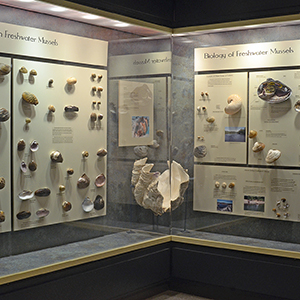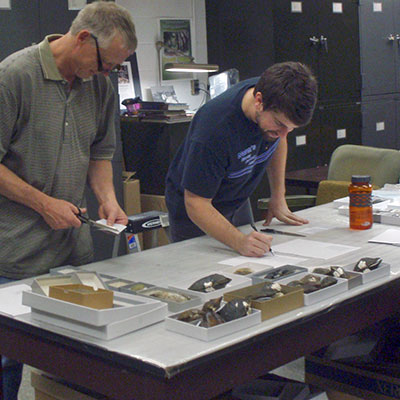Tennessee Freshwater Mussels is divided into three broad subject areas: the biology and diversity of freshwater mussels, the Native American use of freshwater mussels, and the commercial use of freshwater mussels—the button and pearl industries, both cultured and natural.
In addition, the exhibit offers two video segments, one on the life cycle of freshwater mussels and the other on freshwater pearl cultivation in Tennessee. The exhibit is sponsored by Knox County, the Lucille S. Thompson Family Foundation, and the American Pearl Company Inc. in Nashville.
The largest of the exhibit cases features the biology of freshwater mussels and includes examples of the major groups of mollusks along with the largest living bivalve mollusk, the giant clam from the South Pacific. Thirty-two species of freshwater mussels are exhibited to show variation and diversity correlated in part with habitat. Ecological change is reflected in extinct species, loss of habitat due to water quality, and the introduction of new species—the Asian Clam and the Zebra Mussel.
Native American use of freshwater mussels is the subject of a second case. Food was the primary use of freshwater mussels—enormous shell deposits are found at archaeological sites along the Tennessee River. Crushed shell was used by the Mississippian Period Indians (AD 900–1600) for temper, which was mixed with the clay to strengthen it when fired. Other uses included scrapers, hoes, and spoons. Freshwater pearls were occasionally strung or used as insets for eyes on animal effigy pipes. Interestingly, Native Americans did not use freshwater mussels for ornaments, using instead marine shells such as the whelk (Busycon sp.) to produce gorgets, beads, and ear pins.
The third subject area addresses the commercial role of freshwater mussels. In 1887, a German pearl-button maker named J. F. Boepple immigrated to the United States. From the beginning, he realized that the seemingly endless supply of freshwater mussel shells, whose beautiful luster and durability will withstand even the severest laundering, would provide the raw material for a new and significant industry in America. In 1912, nearly 200 plants in the United States utilized valves of freshwater mussels for the manufacture of buttons. The button industry boomed until the development and refinement of plastics following World War II.
Pearls occur naturally in the freshwater mussels of Tennessee and have been used for jewelry since prehistoric times. The freshwater pearl was named the State Gem of Tennessee by the legislature in 1979. In 1963, Tennessean John Latendresse began experiments in nucleating various mussel species. After twenty years of research and development, the first crop of cultured pearls was harvested from a pearl farm on Kentucky Lake. The new exhibit includes wonderful examples of both natural and cultured Tennessee pearls provided by the American Pearl Company and the Latendresse family.
The museum maintains one of the largest and most important research collections of freshwater mussels in the United States.
Paul W. Parmalee




